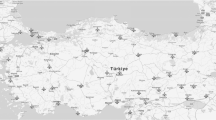Abstract
In recent years, the pollution caused by aviation has sharply been increasing as a result of growing the air traffic. In this study, the emission of pollutants caused by aircrafts’ operations during landing and takeoff cycles was calculated and the impact of meteorological parameters on emission along with its distribution at Imam Khomeini International Airport and Mehrabad Airport was also estimated. Moreover, the pollutants such as carbon monoxide, nitrogen oxides, hydrocarbon and sulphur dioxide were examined. The pollutant emission rate of each aircraft was estimated using the engines’ pollutant database of International Civil Aviation Organization. In order to evaluate the aircraft emission, the flights data of both airports, dated from 2011 to 2016, were used and their total emissions were also calculated. Finally, the atmospheric dispersion model system was used for modelling the dispersion of emissions of these two airports. The results indicated that the highest rate of the total emission at Mehrabad Airport was considered as 2718.47 ton/year in 2016. As for the Imam Khomeini International Airport, the highest rate of total emission was considered to be 4259.12 ton/year in 2015. Moreover, the dispersion of the pollutants along with their distribution at two airports was also modelled and explained, respectively. The results indicated that Mehrabad Airport through which more flights are operated and handled compared to Imam Khomeini International Airport produced lower emission. Moreover, eastern side of these airports suffered from more pollution because of most common wind direction from west to east at these airports.












Similar content being viewed by others
References
CAP 1524 (2017) Civil aviation authority. http://www.caa.co.uk
Cotton WR, Pielke RA Sr, Walko RL, Liston GE, Tremback CJ, Jiang H et al (2003) RAMS 2001: current status and future directions. Meteorol Atmos Phys 82(1):5–29
Department for Transport (2017) UK aviation forecasts. http://www.gov.uk/dft
Elbir T (2008) Estimation of engine emissions from commercial aircraft at a Midsized Turkish Airport. J Environ Eng 134(3):210–215
International Civil Aviation Organization (ICAO) (1995) Exhaust emission data bank, Doc. 9646 AN/943, Montreal, CA
ICAO (2007) Airport local air quality guidance manual
ICAO (2011) Airport air quality manual
Kesgin U (2006) Aircraft emissions at Turkish airports. Energy 31:372–384
Kurniawan JS, Khardi S (2011) Comparison of methodologies estimating emissions of aircraft pollutants, environmental impact assessment around airports. Environ Impact Assess Rev 31:240–252
Lee H, Olsen SC, Wuebbles DJ, Youn D (2013) Impacts of aircraft emissions on the air quality near the ground. Atmos Chem Phys 13:5505–5522
Metropolitan Airports Commission (2010) Greenhouse gas report. Minneapolis, MN
Mohan M, Rupini J (2008) Estimating aircraft emissions and their relative impact on overall ambient air quality over Delhi. In: International workshop on regional and intercontinental transport of air pollution, 13–14 October
Olsthoorn X (2001) Carbon dioxide emissions from international aviation: 1950–2050. J Air Transp Manag 7(2):87–93
Pouresmaeili MA, Aghayan I, Taghizadeh SA (2018) Development of Mashhad driving cycle for passenger car to model vehicle exhaust emissions calibrated using on-board measurements. Sustain Cities Soc 36:12–20
Šabić M, Brdarević S (2010) Aircraft emissions at Bosnia and Hercegovina airports. Zbornik radova sa skupa, ODRŽAVANJE, Zenica, B&H, 10–13 June
Shafabakhsh Gh, Hadjihoseinlou M, Taghizadeh SA (2014) Selecting the appropriate public transportation system to access the Sari International Airport by fuzzy decision making. Eur Transp Res Rev 6:277–285
Shafabakhsh Gh, Taghizadeh SA, Mehrabi Kooshki S (2018) Investigation and sensitivity analysis of air pollution caused by road transportation at signalized intersections using IVE model in Iran. Eur Transp Res Rev 10:7
Shahbazi H, Taghvaee S, Hosseini V, Afshin H (2016) A GIS based emission inventory development for Tehran. Urban Clim 17:216–229
Shirmohammadi F, Sowlat MH, Hasheminassab S, Saffari A, Ban-Weiss G, Sioutas C (2017) Emission rates of particle number, mass and black carbon by the Los Angeles International Airport (LAX) and its impact on air quality in Los Angeles. Atmos Environ 151:82–93
Staplesa MD, Malinaa R, Suresha P, Hilemanb JI, Barretta SRH (2018) Aviation CO2 emissions reductions from the use of alternative jet fuels. Energy Policy 114:342–354
Turgut ET, Rosen MA (2010) Assessment of emissions at busy airports. Int J Energy Res 34(9):800–814
World Health Organization (WHO) (2012) Health and sustainable development. https://www.who.int/sustainable-development/transport/health-risks/air-pollution/en/
Zhu Y, Fanning E, Yu RC, Zhang Q, Froines JR (2011) Aircraft emissions and local air quality impacts from takeoff activities at a large International Airport. Atmos Environ 45(36):6526–6533
Acknowledgements
The authors give special thanks to Iran Airports Company and I.R. of Iran Meteorological Organization for providing related data and information.
Author information
Authors and Affiliations
Corresponding author
Ethics declarations
Conflict of interest
The authors declare no conflict of interest.
Additional information
Editorial responsibility: Mohamed F. Yassin.
Electronic supplementary material
Below is the link to the electronic supplementary material.
Rights and permissions
About this article
Cite this article
Taghizadeh, S.A., Shafabakhsh, G.H. & Aghayan, I. Evaluation of aircraft emission at Imam Khomeini International Airport and Mehrabad International Airport. Int. J. Environ. Sci. Technol. 16, 6587–6598 (2019). https://doi.org/10.1007/s13762-019-02381-9
Received:
Revised:
Accepted:
Published:
Issue Date:
DOI: https://doi.org/10.1007/s13762-019-02381-9




